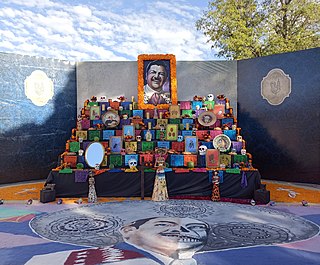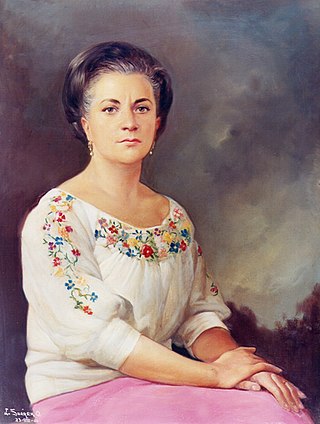
María Elena Velasco Fragoso was a Mexican actress, comedian, singer-songwriter and dancer. She is best known for creating and portraying La India María, a comical character based on indigenous Mexican women.

José Alfredo Jiménez Sandoval was a Mexican singer-songwriter, whose songs are regarded the basis of modern regional Mexican music and rancheras. During his lifetime, he wrote over a thousand songs, which have been covered by various artists.

Jarabe Tapatío, often referred to as the Mexican hat dance, is the national dance of Mexico. It originated as a courtship dance in Guadalajara, Jalisco, during the 19th century, although its elements can be traced back to the Spanish zambra and jarabe gitano, which were popular during the times of the viceroyalty. Female dancers traditionally wear a china poblana outfit, while the male dancers dress as charros, and their steps are characterized by flirtatiously stepping around the brim of their partner's hat.

Charrería is a sport and discipline arising from equestrian activities and livestock traditions used in the haciendas of old Mexico.

La Calavera Catrina had its origin as a zinc etching created by the Mexican printmaker and lithographer José Guadalupe Posada (1852–1913). The image is usually dated c. 1910-12. Its first certain publication date is 1913, when it appeared in a satiric broadside as a photo-relief etching.

The 4th Annual Latin Grammy Awards were held in Miami at the American Airlines Arena on Wednesday, September 3, 2003. It was the first time the telecast was held outside of Los Angeles. Juanes was the night's biggest winner winning a record five awards including Album of the Year. He tied his own record winning five awards again five years later in 2008. Juan Luis Guerra and Calle 13 also tied this record in 2007 and 2009 respectively.

The 5th Annual Latin Grammy Awards were held on Wednesday, September 1, 2004, at the Shrine Auditorium in Los Angeles.

A rebozo is a long flat garment, very similar to a shawl, worn mostly by women in Mexico. It can be worn in various ways, usually folded or wrapped around the head and/or upper body to shade from the sun, provide warmth and as an accessory to an outfit. It is also used to carry babies and large bundles, especially among indigenous women. The origin of the garment is unclear, but Indigenous women of Mesoamerica were the primary weavers of the first rebozos, often crafted with body-tensioned or back-strap "otate" looms. Spaniards used it in religious situations to conceal the bare bodies of indigenous women. Rebozos were quickly influenced by the fringed shawls of the Philippines and Spanish mantillas as a result of colonization. Traditional versions of the garment show indigenous, European and Asian influences. Traditional rebozos are handwoven from cotton, wool, silk and rayon in various lengths but all have some kind of pattern and have fringe, which can be fingerwoven into complicated designs. The garment is considered to be part of Mexican identity. It has been prominently worn by women such as Frida Kahlo, actress María Félix and former Mexican first lady Margarita Zavala and still popular in rural areas of the country. However, its use has diminished in urban areas.

Roberto Montenegro Nervo was a painter, muralist and illustrator, who was one of the first to be involved in the Mexican muralism movement after the Mexican Revolution. His most important mural work was done at the former San Pedro and San Pablo monastery but as his work did not have the same drama as other muralists, such as Diego Rivera, he lost prominence in this endeavor. Most of his career is dedicated to illustration and publishing, portrait painting and the promotion of Mexican handcrafts and folk art.
The Sor Juana Inés de la Cruz Prize is a literary prize awarded to a book written in Spanish by a female author. It is organized by the Guadalajara International Book Fair, based in Guadalajara, Jalisco, Mexico. Current winners of the prize receive USD$10,000.

Catarina de San Juan known as the China Poblana was an Asian slave who, according to legend, belonged to a noble family from India. She was brought to Mexico through the Spanish East Indies and has been credited since the Porfiriato with creating the China Poblana dress. After converting to Catholicism in Cochin —an Indian city where she was kidnapped by Portuguese pirates—Mirra was given the Christian name Catarina de San Juan, the name she was known as in Puebla de Zaragoza where she worked as a slave, married, and eventually became a beata - a religious woman who took personal religious vows without entering a convent. Upon her death, Catarina de San Juan was buried in the sacristy of the Jesuit Templo de la Compañía de Jesús in Puebla, in what is popularly known as Tumba de la China Poblana.

The baro’t saya or baro at saya is a traditional dress ensemble worn by women in the Philippines. It is a national dress of the Philippines and combines elements from both the precolonial native Filipino and colonial Spanish clothing styles. It traditionally consists of four parts: a blouse, a long skirt, a kerchief worn over the shoulders, and a short rectangular cloth worn over the skirt.

Talavera pottery is a Mexican and Spanish pottery tradition from Talavera de la Reina, in Spain. In 2019, it was included in UNESCO's Representative List of the Intangible Cultural Heritage of Humanity.
Los Yonic's are a Mexican grupero band formed in 1975.
The 8th Annual Premios Oye! took place at the Auditorio del Estado in Guanajuato, Guanajuato on November 24, 2009. The nominees were announced on September 29 with Alexander Acha and Banda el Recodo receiving 4 nominations, followed by Fanny Lu, Jenni Rivera, Vicente Fernández and Zoé with 3 each one. It will be celebrated in Guanajuato in order to commemorate the 200th Anniversary of the Mexican Independence Day Grito de Dolores. Rapahel will be awarded by the Academia Nacional de la Música en México for his 50 years or career. The voting process is certified by PricewaterhouseCoopers.

Folk dance of Mexico, commonly known as baile folklorico or Mexican ballet folk dance, is a term used to collectively describe traditional Mexican folk dances. Ballet folklórico is not just one type of dance; it encompasses each region's traditional dance that has been influenced by their local folklore and has been entwined with ballet characteristics to be made into a theatrical production. Each dance represents a different region in Mexico illustrated through their different zapateado, footwork, having differing stomps or heel toe points, and choreography that imitates animals from their region such as horses, iguanas, and vultures.

Laura Méndez de Cuenca, was a Mexican writer and poet.

María Esther Zuno Arce was the wife of Mexican President Luis Echeverría and the first lady of Mexico from 1970 to 1976. She refused to adopt the standard title of primera dama, preferring to be called compañera. She was known for her efforts to support women's rights and social welfare in Mexico.
This article includes an overview of the major events and trends in Latin music in the 1970s, namely in Ibero-America. This includes recordings, festivals, award ceremonies, births and deaths of Latin music artists, and the rise and fall of various subgenres in Latin music from 1970 to 1979.
![Poblanas (women of Puebla), in a 19th-century vignette. To the left appears a chinaco [es]. Poblanas.jpg](http://upload.wikimedia.org/wikipedia/commons/thumb/3/39/Poblanas.jpg/250px-Poblanas.jpg)




















